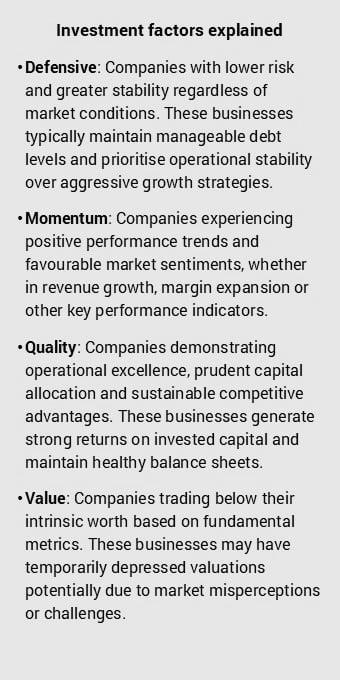 Beneath the market turmoil, companies with strong defensive strategies significantly outperformed companies that are strong in other factors since the tariff announcement. Regardless of their industries, companies with the lowest risk profiles delivered cumulative returns of approximately 20 percent by the end of March.
Beneath the market turmoil, companies with strong defensive strategies significantly outperformed companies that are strong in other factors since the tariff announcement. Regardless of their industries, companies with the lowest risk profiles delivered cumulative returns of approximately 20 percent by the end of March.
In other words, the most defensive companies within the technology sector outperformed those in the least defensive technology companies, and the same pattern is repeated across consumer goods, healthcare and other sectors. Even when an entire sector faced tariff headwinds, companies with stronger defensive characteristics significantly outperformed their riskier peers around mid-February, coinciding with the market’s recognition of the implications of the tariffs.
Markets also began to reward companies for their “quality”, specifically those with stronger balance sheets and operational stability. This pattern reinforces industry-level findings: more profitable firms may be better positioned to weather supply chain disruptions. By contrast, cheap stocks did not outperform their more expensive peers, and neither did stocks with recent price run-ups outperform their peers with lower recent performance.
Factor performance offers an important complementary perspective. Navigating this uncertain landscape requires a sound understanding of both industry exposure and factor positioning for a more complete picture of a company’s vulnerabilities and opportunities.
The complexity of interconnectedness
At the same time, the interconnectedness of industries and supply chains brings added complexity. The pronounced divergence between defensive and other factors may reflect the underlying supply chain dynamics driving market performance. Companies exhibiting defensive and quality characteristics – those with domestic operations, pricing power and simple supply networks, or that are under the essential product category – have demonstrated resilience despite the broader market decline.
Conversely, companies lacking these attributes have suffered disproportionately regardless of their industry. This pattern suggests that the fundamental mechanism through which tariff impacts propagate, which transcends traditional sector boundaries, could well be supply chain exposure.
The impact of tariffs cascades through supply chains in complex ways, creating secondary and tertiary effects beyond direct importers. My recent research shows how the effect of policy uncertainty can affect up to two degrees of connections (i.e. supplier’s suppliers). In some cases, the overall effects on second-degree connections may be even larger than direct exposures since they are aggregated from multiple sources.
This propagation mechanism can explain why companies with seemingly limited direct exposure to the disruption may show significant negative returns. The interconnected nature of modern production means few sectors remain truly insulated.
The diversification dilemma
In previous settings, when specific products were targeted, companies could mitigate trade policy risks by diversifying suppliers. However, Trump’s sweeping tariffs create two challenges. First, unlike previous tariffs targeted at the product level, broad-based tariffs affect entire categories simultaneously and significantly constrain diversification options. The difference between surgical and blanket tariffs fundamentally changes the strategic playbook. Diversification can no longer offer meaningful protection. Now, the question becomes whether to restructure entire supply chains or absorb costs.
Second, analysis shows that the impact on firms depends on their customer base composition. We found that firms mainly serving the domestic market decrease their supplier base abroad when US trade policy uncertainty increases. In contrast, firms with a larger foreign market increase their number of foreign suppliers. This throws a wrench in the reshoring narrative, which assumes companies primarily serve domestic consumers. In fact, around 40 percent of globally engaged American firms derive more than half of their revenue from foreign sources, making proximity to those markets more important.
An important takeaway is that companies focus their production where their customer base is and reshoring manufacturing to the home country may not always be a strategic move. Moreover, retaliatory trade actions can disrupt business models. One example is TSMC, which is increasing production in America, as that’s where its primary market is. However, due to retaliation, they potentially face tariffs on raw materials and heavy machinery entering the country.
This creates a bifurcated response pattern: domestically focused firms may indeed respond to tariffs by reshoring, while internationally focused firms might accelerate their global migration of production to maintain proximity to customers, especially if the country of production and sale are not embroiled in a trade war. This has catalysed the formation of new trade blocs and sped up regional integration, such as the China, Japan and South Korea alliance.
More recent research on partisan supply chains also highlights the role of political ideology in sourcing decisions. This suggests that beyond direct tariff impacts, the political environment may accelerate shifts in global sourcing based on ideological alignment – adding another layer of complexity to corporate decision-making.
Policy implications: Rebalancing or disruption?
The central question remains: Beyond the growing pains, will these tariffs achieve industrial rebalancing as intended? Early market evidence suggests more disruption than rebalancing. While some domestically focused firms may consider reshoring, the widespread negative returns indicate markets expect more economic damage than restructuring benefits in the near term.
Overall, this analysis reveals a complex pattern of industry-specific and performance factor-related impacts beneath the broadly negative market reaction to recent tariff announcements. This heterogeneity illuminates which sectors face the greatest challenges and where investment opportunities lie within sectors. More importantly, it provides insights into the potential effectiveness of the policy in achieving its stated rebalancing objectives.
As markets digest these policy changes, further heterogeneity will likely emerge. What remains clear is that corporate strategists and policymakers require nuanced analysis rather than aggregate assessments to navigate the tumultuous trade landscape.
“INSEAD, a contraction of “Institut Européen d’Administration des Affaires” is a non-profit graduate-only business school that maintains campuses in Europe, Asia, the Middle East, and North America.”
Please visit the firm link to site





